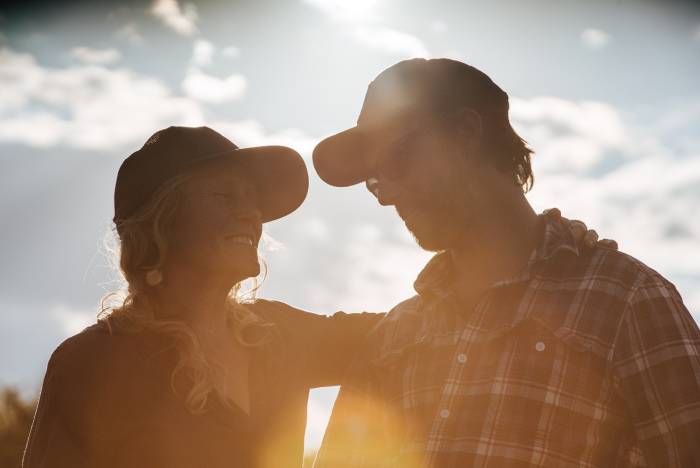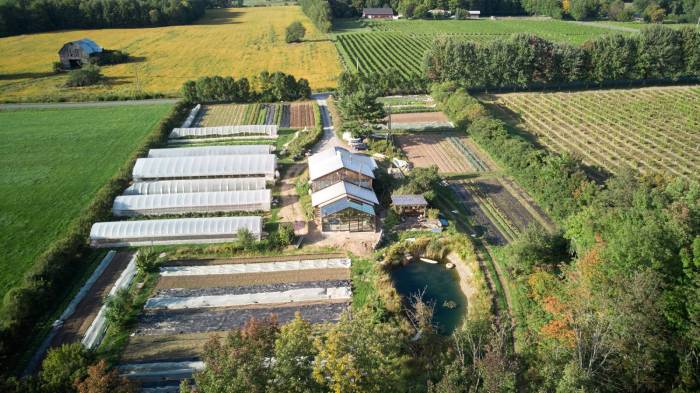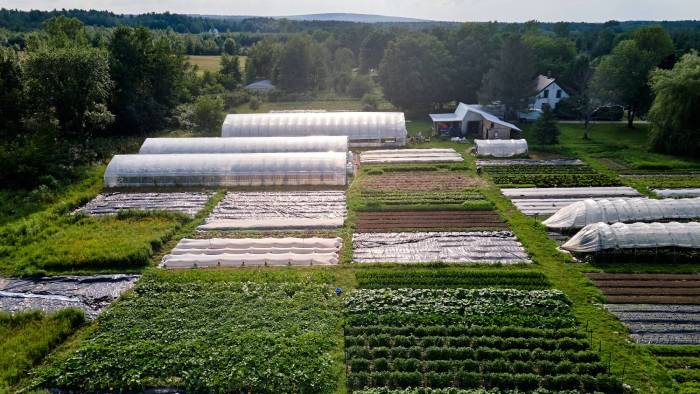Is it your dream to start a small organic farm with a diversified production that respects both people and the planet? That dream is more accessible than you might think. In this article, we explore the key principles of what is biointensive farming — a question many new growers are asking — as practiced by Jean-Martin Fortier, an approach now embraced by thousands of small-scale growers around the world.
Pillars of the Market Gardener’s Approach to Biointensive Farming
Human-Centered Design: The Power of Permanent Raised Beds
One of the core principles of Jean-Martin Fortier’s biointensive method is the use of appropriate technology that’s scaled to suit small plots of land. The efficiency of these tools is made possible by one key design element: the adoption of permanent raised beds. These standardized beds not only eliminate the need for heavy machinery to shape or maintain growing areas but also establish a consistent structure across the farm — a format that has since become a standard in the market gardening world.
At the heart of this toolset is the broadfork, used to deeply loosen the soil without inverting it. This helps preserve soil structure, encourages microbial life, and promotes healthy root development — a key factor in supporting close plant spacing and the high-density production that defines biointensive farming. For surface cultivation — the shallow soil work required to prepare beds for new plantings and achieve the ideal tilth — JM Fortier recommend a variety of tools depending on the context. Options include a walk-behind tractor (BCS), a wheel hoe, or a specialized tool like the Tilther, which stirs just the top layer of soil with precision and minimal disturbance. Each of these tools plays a role in maintaining the bed’s structure while keeping the system fast and efficient. Silage tarps are used as a no-till soil preparation tool, naturally suppressing weeds and helping decompose crop residues.

For weeding and cultivation, a variety of precision hoes make the work efficient and manageable. Tools like the collinear hoe, stirrup hoe, and other hand cultivators allow for ergonomic, accurate work close to plants, effectively reducing weed pressure without disturbing the integrity of the permanent beds. When it comes to planting, a range of precision seeders ensures consistent seed spacing and depth, which is essential for maximizing crop uniformity and overall yields. And to protect crops while extending the growing season, row covers, low tunnels, and insect netting are key components of the system, offering passive yet powerful protection against pests, frost, and unpredictable weather.
This tool-based system is not only efficient — it’s also highly accessible. Many of the tools are affordable, easy to use, and designed to support a workflow that reduces physical strain while preserving soil health. To see these tools in action and learn how they fit into a successful small-scale farm system, check out the video 30 MUST-HAVE Tools For Small Regenerative Farms & Market Gardens :
Building Soil Health: Nurturing Structure and Organic Vitality
Equally important to JM’s method are the growing techniques that allow a grower to maximize plant potential while minimizing labor, which, as JM often points out, is the name of the game. At the heart of his approach are detailed crop itineraries: clear, step-by-step sequences that guide each crop from bed preparation through to harvest. These include precise techniques like training tomatoes with two leaders for balanced yield and airflow, pruning peppers to three heads to optimize fruit production and reduce plant crowding, or harvesting celery over multiple months by cutting a few stalks at a time instead of pulling entire plants. These methods not only stretch productivity over time, but also reduce the need for constant replanting — saving labor while increasing overall yield.
This practical knowledge is at the core of the Market Gardener Masterclass, an online program where JM Fortier shares these proven crop itineraries in detail. Each one covers all aspects of the growing process — from soil preparation and transplanting to spacing, fertility management, and harvest timing — making it possible for growers to replicate success, crop after crop.
Smart Planning: Using Crop Rotation for Better Production
The third pillar of JM Fortier’s approach is crop planning — and it’s often the difference between a farm that feels chaotic and one that runs with clarity and purpose. While tools and techniques are essential, it’s the planning that unlocks the full potential of any biointensive farm. In fact, for growers seeking to truly understand what is biointensive farming, crop planning reveals how efficiency and ecological balance can work hand in hand. At its core, crop planning is about making intentional decisions about what to grow, where to grow it, and when, to ensure that every square foot of the farm is used as efficiently as possible throughout the season. A grower does this by carefully planning crop sequences, rotations, successions, and planting dates, all of which streamlines labor across the entire growing season. This planning also makes harvests more consistent and market-ready, aligning production with real customer demand.

Today, tools like Heirloom — a crop planning software designed specifically for small-scale biointensive farms — help growers put these principles into practice. Heirloom allows farmers to map their fields, plan successions, organize transplant and harvest schedules, and adapt quickly when conditions change. As JM puts it:
“Whether you’re managing five beds or fifty, crop planning is what ties your tools, techniques, and design together — turning ambition into a working, profitable system. It’s the foundation that makes all the rest possible.”
Who’s behind The Market Gardener?
Jean-Martin Fortier — affectionately known to many as JM — founded Les Jardins de la Grelinette with his partner Maude-Hélène Desroches in 2004. Located in the Eastern Townships of Québec and established on approximately 1.5 acres of farmland, their microfarm grows a rich diversity of fresh organic vegetables, which they sell through a long-standing CSA and at a local farmers market.

What makes this farm remarkable isn’t just its small size — it’s how much it produces in terms of bottom line. From the very beginning, the farm was intentionally designed and established on a limited plot. Because the land was landlocked and couldn’t be expanded, Jean-Martin and Maude-Hélène spent years refining a system that would allow them to grow significantly more crops on the same footprint to meet strong and growing demand. They farm without a tractor, relying instead on appropriate technology and human powered hand tools, and have done so profitably, avoiding the high costs associated with mechanization.
Rather than following the conventional organic model that depends on economies of scale, large machinery, and vast acreage, they took a different path, focusing instead on cutting out middlemen and concentrating production in both space and time. Through the use of tight plant spacing, successive plantings, and season extension strategies, they developed a precise and efficient system rooted in human-scale techniques. These practices form the foundation of biointensive farming: a method designed to make the most of every square inch of land while delivering both high yields and long-term soil health. It’s a model that has proven to be not only productive and resilient, but financially sustainable as well — echoing the findings of the Food and Agriculture Organization of the United Nations, which states that biointensive farming is particularly well-suited for small-scale growers, enabling them to achieve strong yields on limited land with minimal financial input (FAO, 2014).

The story of JM Fortier
In 2012, JM Fortier published a book in which he shares the farming techniques he and Maude-Hélène use at La Grelinette: The Market Gardener: A Successful Grower’s Handbook for Small-Scale Organic Farming. The book was written to help other growers better understand how to set up a productive and profitable small farm using biointensive principles. It serves as a practical blueprint for young and not-so-young people who dream of a career in organic farming but don’t necessarily have the financial means or family land that more traditional farming often requires. At its core, the book promotes a model of farming that is not only economically viable, but also rooted in ecological responsibility and human-scale values.

In the years that followed, JM used his expertise to launch Ferme de Quatre-Temps, a regenerative farming project also based in Québec, Canada. Designed not only to produce food but also to serve as a hands-on training ground, the farm is dedicated to mentoring a new generation of growers in biointensive methods and supporting them in launching their own successful farm enterprises. Around this time, JM gained widespread recognition — even earning the nickname “rockstar farmer” — thanks in part to the success of the television series Les Fermiers, , which follows his work training young apprentices on the farm.

Although the techniques and farming model developed by JM Fortier are innovative and distinct from what many consider traditional organic farming, they are far from new. JM himself often emphasizes that his approach is part of a broader lineage. The biointensive method draws inspiration from earlier pioneers such as Eliot Coleman, John Jeavons, and Alan Chadwick, as well as from the rich traditions of 19th-century French market gardening — which, long before the rise of industrial agriculture, were feeding a city of over three million people in Paris with fresh, seasonal produce grown on small, intensively managed plots just outside the city limits.
What makes this model especially relevant today is how well it fits the growing resurgence of small-scale farming, particularly among those with limited land, minimal capital, and no interest in equipping their farms with heavy machinery. Instead, this system offers a realistic, low-barrier path to growing food efficiently and profitably, using simple tools, smart techniques, and thoughtful design.
For many aspiring growers working with limited land and tight budgets, understanding what is biointensive farming is a critical first step toward designing a farm that is both productive and manageable.

Become a Full-Time Market Gardener
It probably hasn’t escaped you that current industrial agricultural practices are a dead-end – completely unsustainable. Convinced that the future is in small-scale organic farming, JM Fortier has developed a method that is already improving the lives of many growers. His mission: to give you the keys to understanding how to work efficiently and to generate profits while respecting nature. There is an urgent need to re-imagine our approach to growing food and to prove that it is indeed possible to achieve community resilience by adopting small-scale organic agriculture.
Are you at the beginning of your process and looking to learn more about JM’s principles of bio-intensive farming? We invite you to take a look at our Introduction to Market Gardening course. This course provides a comprehensive overview of everything you need to know when considering becoming an organic biointensive farmer.
If you are ready to start your own farming project, the Market Gardener Masterclass is a comprehensive online program that teaches all the steps to establish a successful organic mixed vegetable production on a small-scale land. Based on 20 years of farming experience, JM Fortier has designed this program to allow you to obtain consistent results that will support the success of your farm.












